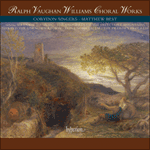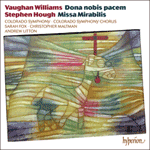
Welcome to Hyperion Records, an independent British classical label devoted to presenting high-quality recordings of music of all styles and from all periods from the twelfth century to the twenty-first.
Hyperion offers both CDs, and downloads in a number of formats. The site is also available in several languages.
Please use the dropdown buttons to set your preferred options, or use the checkbox to accept the defaults.

| Christopher Maltman (baritone), Sarah Fox (soprano), Colorado Symphony Chorus, Colorado Symphony, Andrew Litton (conductor)» More |
The words are selected from a variety of sources, principally from the scriptures and Whitman. The interpolation of the one into the other pre-echoes Britten’s scheme in his War Requiem of twenty-five years later. Skilfully though the libretto is compiled, Dona nobis pacem cannot be said to be a unified musical conception, but the sheer quality of the music has ensured that it has outlived the occasion for which it was written and, alas, the subject grows no less topical.
The cantata is in five main sections:
Agnus Dei (Lento): After two bars of orchestral chromatic chords, the soprano enters pianissimo with the Latin prayer from the Liturgy, her ‘Dona nobis pacem’, the work’s principal leitmotif, thrice repeated. The chorus echoes this plea for peace and then, in a sudden discordant outburst, the soloist and chorus cry it to the heavens. As this climax subsides, the drums begin beating and the music flows without a break into the second section.
Beat! beat! drums! (Allegro moderato): Trumpet calls over beating drums are a prelude to the chorus’s words from Whitman’s Drum-Taps, a declamatory description of the overwhelming effects of war on town and countryside. Short, harsh, ejaculatory phrases convey the ruthlessness of war.
Reconciliation (Andantino): The stridency of the previous section is banished by strings high in their register and the musings of a solo violin, in a serene slow movement typical of Vaughan Williams. The words are again from Drum-Taps and are given to the baritone soloist with his message of ultimate reconciliation sung to music of notable compassion. This section is repeated by the chorus, after which the soloist continues with the passage ‘For my enemy is dead, a man divine as myself is dead’. This again foreshadows Britten’s use of Wilfred Owen’s Strange Meeting in the War Requiem. The chorus repeats the first section and the soprano quietly interjects her prayerful ‘Dona nobis pacem’ to close the movement.
Dirge for two veterans (Moderato alla marcia): Over a steady drum rhythm a solemn march-tune introduces the Whitman word-picture of the burial by moonlight of a father and son who have been killed in battle. The chorus sings this movement, setting the scene with a description of the rising of the moon and the arrival of the cortège at the double grave. The march is thundered out in C major, the chorus silent. The vocal writing now becomes modal before the intense climax and quiet ending. This movement’s melodic directness is apposite to the directness of the message of this work and, without knowing it, one would not guess the music’s earlier date.
The Angel of Death has been abroad: To a sparse accompaniment, the baritone declaims John Bright’s words about the Angel of Death, spoken in the House of Commons in 1855 in a debate on the Crimean War. The soprano soloist and chorus renew their anguished cry for peace, the chorus following this with man’s perennial despairing question ‘Is there no balm in Gilead?’. Vaughan Williams suggests that there is, for the baritone sings an assurance of peace. Now the orchestra begins to glow radiantly with a beautiful passacaglia-like melody, as the chorus sings of nations at peace with one another. As this vision intensifies, the vocal and orchestral writing become contrapuntal in texture and the bells begin to peal. To the passacaglia-tune a new heaven and a new earth are invoked and finally the Christmas message of peace and good-will toward men. The last three words are reiterated emphatically, followed by a coda in which the chorus reaffirms the soprano’s final entreaty, ‘Dona nobis pacem’, so bringing the cantata to a quiet and peaceful ending in a final impression of optimism.
from notes by Michael Kennedy © 2015
 Vaughan Williams: Choral works Vaughan Williams: Choral worksIssued to mark the fiftieth anniversary of Vaughan Williams’s death, this collection is tantalizing: it starts with one of the best-selling discs in the catalogue, the Serenade to Music, and includes such favourites as the Five Mystical Songs and The ...» More |
 Vaughan Williams: Dona nobis pacem; Hough: Missa Mirabilis Vaughan Williams: Dona nobis pacem; Hough: Missa MirabilisVaughan Williams’ dramatic anti-War cantata is movingly performed alongside Stephen Hough’s inspiring new Mass setting.» More |

